Home | Front Page | Index | Blog | New | Contact | Site Map
Leon
Managua
Granada
Ometepe
People
Franz Orschel
Foto Show
Route Maps
Belize
Guatemala
Honduras
Costa Rica
Panama
Mexico 2003-04:
2003-04
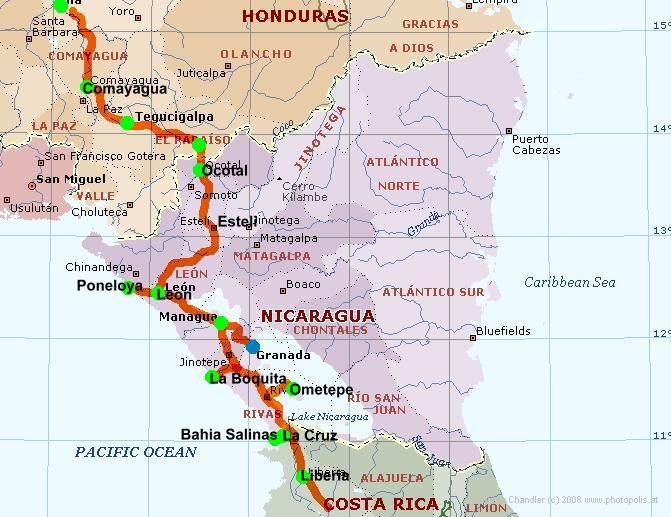
Nicaragua Route |
Nicaragua for us was almost as strange as being in the land of Oz. If feels like we grew up with the Contra war (we didn't; we're much older). But our ideas of it were mostly framed about hearing about the Sandinista revolution and the Reagan-financed counter (Contra) revolution. We should have known better, or slightly better, because we arrived a few months short of the 25th anniversary of the July 19 arrival in power of the Sandinistas. Two months after we were there, Ronald Reagan himself died.
Relatively early in the morning we drove up the hills to the border and crossed into Nicaragua at Los Manos. We had the usual people offering to be guides, but we easily did without them. We went on to the small town of Ocotal, the first with a hotel. It really has little of interest, but it was a quiet place for lunch and then a walk. Just at the eastern edge there is a deep and impressive river valley; the river moseys over to Honduras and forms the border, running all the way to the Carribean. The next morning we went on to Esteli, bigger and with a Church to look at, where we extended lunch into a shopping expedition — would you believe it — at Payless Shoe Source, where we each got non-leather sandals and Gerry a new set of tennis/running shoes.
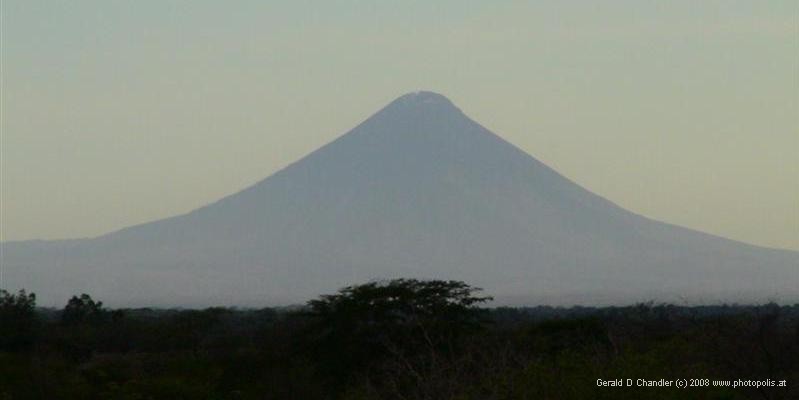
1280 m (4300 ft) Volcan Momotombo, Nicaragua |
The afternoon was spent in the drive to Leon. The second half was through about 40 km of the most deserted area we have been in any Central America country: flat, dry, nearly treeless, but not desert. As we approached Leon we got our first view of Fuji-like Momotombo, a volcano that destroyed the original Leon in about 1620 and whose eruption in 1902 helped shift American interest in a canal from Nicaragua to Panama.

Supaya Beach Resort, our second hotel and restaurant at Poneloya
|
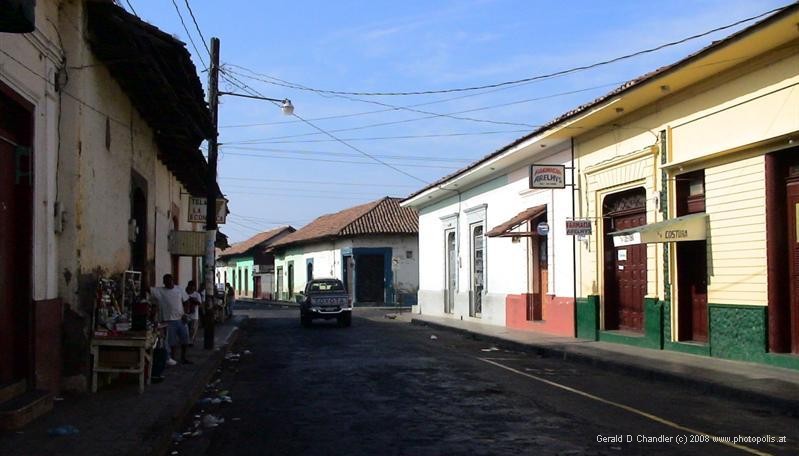
Street in Leon a few blocks south-west of center |
It was back to Leon for us and this time; at the third hotel we saw we found a good bargain. Funny how these things are: half a mile a way a much worse hotel was sold out and one nearby about the same value was twice the price. We had a nice three days in Leon, getting to know its past and present left-wing tendencies, then and now a bastion for Sandanistas. There are monuments and wall murals extrolling Sandinista heros and a book shop with anti-American posters. Leon has more, which we appreciated more: two nice museums which are so new they are not in LP; streets with charming old houses, some occupied by the poor and some handsomely restored. The Cathedral and San Francisco Church are both worth visits and we saw pre-Easter celebrations at both. We went to the San Francisco Church for a Sunday charity breakfast and were disappointed by the poor selection and the haphazard organization.
Our custom is to save gas and driving by making as many stops as we can along the way rather than either backtracking or making excursions from our temporary abode. So we decided to see Leon Viejo on the way to Managua and it was a good choice. The original Leon was founded on the western end of Lake Managua in 1524 and about a hundred years later buried by Momotombo and soon forgotten. Relocated by archeologists in 1967 the site is now a national park. We toured it with an excellent guide, a young man from the adjacent village of Momotombo, whose Spanish diction was so clear that we understood everyword. Afterwards we went down to the lake, which has an unattractive shore. From there we dreamed about an ascent to the crater of Momotombo.
In another hour we were in Managua and within half an hour had managed to find Franz Orschel's bed and breakfast. We sort of had an address but didn't understand it and didn't have a map with his street. But since we knew it was near the new Cathedral we went there and started asking questions. Each got us closer and by the third we were at the door. We had met his daughter, who is a radiologist, in Guatemala City while getting a health exam at the university hospital. We found him to be such a good host that we stayed six days.

Statue to Worker |

Sandanista Statue to Worker, Managua |
Our first day in Managua we limited ourselves to going out to seeing the nearby shopping center and the new Cathedral. Neither, expecially the first, fit the picture we had of "revolutionary" Managua. The shopping center would fit right in to the USA, even if nowhere near the size of megamalls; it shows there is a class with money to spend. The Cathedral replaced the colonial one heavily damaged by an earthquake. Like the Liverpool Cathedral, and probably many others, its modern design, dictated partly by tastes that we don't share, and necessary economies that we understand, didn't please us. We made one excursion to central, old Managua, walking both ways in a lot of heat. We saw the old Cathedral, the adjacent National Culture Palace, the unpleasant lake front, the decrepit "modern" square where Pope John Paul II performed mass on his visit, several Sandanista monuments to workers and revolution, and another shopping center where we cooled off, ate, and saw "Terminator III" dubbed in Spanish.
We hemmed and hawed a long time in deciding what to do about Grenada. We thought that because Easter was approaching that it would be a colorful place to be. And because of that it would be hard to get a hotel. So in the end, and because we were so comfortable at the Orschel's, we decided to drive the 60 km and return in the same day, a break with our usual practice that hurt the soul. We went on Easter Sunday and to our surprise we had hardly been in the car when we were detoured around a religious procession heading toward the new Managua Cathedral. Fearing we were missing something interesting we went on. The road is flat, but the traffic made it burdensome to drive, but we got there in an hour.
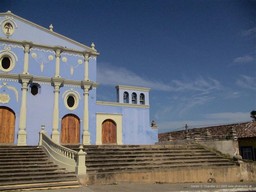
Iglesia de Guadlupe, Granada |
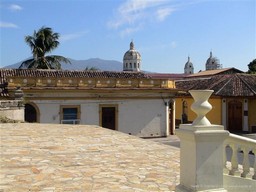
Porch, Iglesia de San Francisco |
Granada is an attractive place, if not as attractive as the Spanish cities with a richer colonial heritage. We rank it well below Antigua, Guatemala and above Comayagua and Leon. The central square is nice and an adjoing square/plaza is terrific. We attended Easter mass (or most of it) and followed an Easter procession around the main square and nearby. Then we walked down Calle La Calzada to the lake front where there was no hint that it was Easter; rather people were bicyling, sunning themselves, and picnicing. We skipped the tourist trips to nearby islands, a pony ride, and even a ride on a "trolley car" that looked like it was imported from the US. We saw the Convento and Iglesia de San Francisco, dating to 1585, and now housing a museum. When we first approached it looked as if it was all locked up, but we got in and particularly liked the collection of carved pre-Columbian figures.

Ceramic Souvenirs, San Juan de Oriente |
The next day we treated the Orschels to lunch. The following day they more than repaid us by taking us out for a day to see all of the things we had missed between Managua and Granada. They took us to Masaya and we stopped at the Mercado Viejo, now gentried as much as Boston's Fanueil Market. From there it was up, up the hill to Catarins where we could look down, down, at Laguna de Apolya in the crater of a volcano. We looked over it to Granada and make out the general outline of our visit and look out on Lake Nicaragua until it disappeared in the haze, perhaps only 20 miles out of its 120 miles. From there we we went on to make a stop at the craft village of San Juan de Oriente, where we stopped in a half dozen shops. Their wares ranged from the great to the bizarre to the distasteful. We'd like to have bought a lot of the better stuff, but that was impractical.

La Boquita Good Food |
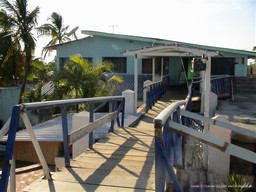
Bad Accommodation, La Boquita |
From Managua it was off to the beach, this time La Boquita Beach. We'd chosen the place because there had been an article in the English-language Nicaragua Times about undiscovered places. We wish we'd never discovered this one. There was a new hotel that we ruled out because it was way over budget, way over crowded, and way too noisy. We chose instead a simple place that was being rebuilt. Our room. although simple, had a great view of the sea, and the restaurant was nice. But when the power failed and the fan went off we roasted.
Gerry kept hoping to see a volcano up close so we set off for the twin volcanos on Ometepe, an island on the southern shores of Lake Nicaragua. Getting there meant taking a ferry; we just missed the morning one so reserved for the afternoon one and went off for a meal and look about in nearby Rivas. There we managed to do internet. At lunch we met a Nicaraguan-American who was visiting his family; he told us about being a fighter on the Sandanista side; he now regrets his youthfull ignorance.
We easily got the car the ferry to Ometepe and an hour later were there. As soon as we got off we had to find a hotel. Nothing pleased us in Moyogalpa, ferry port and largest town on the island, so we set off for Altagracia. Gerry was confident we'd get there and get there before dark, Jan very much doubting it. Inspite of ten miles of very rutted roads we did and found a more than acceptable place. Shortly after arriving we were approached about sharing the expenses of a guide and car to the waterfall at the base of Volcan Maderas, at 1394 m the junior partner to Volcan Concepcion, 1610 m. We said yes and too early the next morning four of us and a guide set out. The walk was actually easy, though we puffed a lot and Gerry sweated his usual buckets.
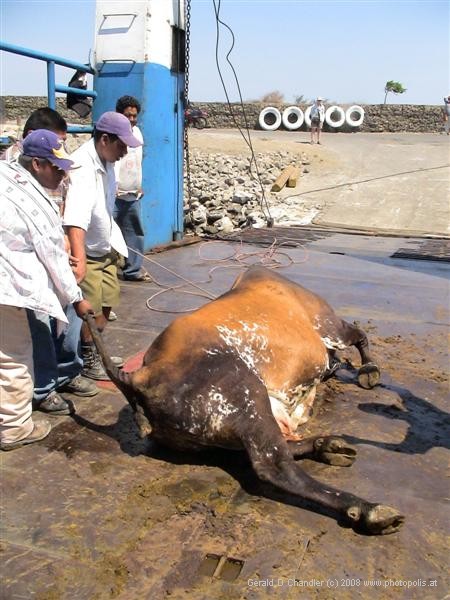
Cow leaving Ometepe ferry, tail-assisted |
Unwinding our visit to Ometepe meant going back the same rutted ten miles; we did it a little more comfortably and also got lots of views of Concepcion. The ferry ride back was enlivened by three cows who made such a mess with their excrement that one of them could not stand up. It was dragged off by the tail. We drove off, quickly passed through Rivas, and drove along Lake Nicaragua getting great views of lake and the twin volcanos. In an hour and a half we were at the border town, Penas Blancas, and in another hour were going through Costa Rican formalities.
